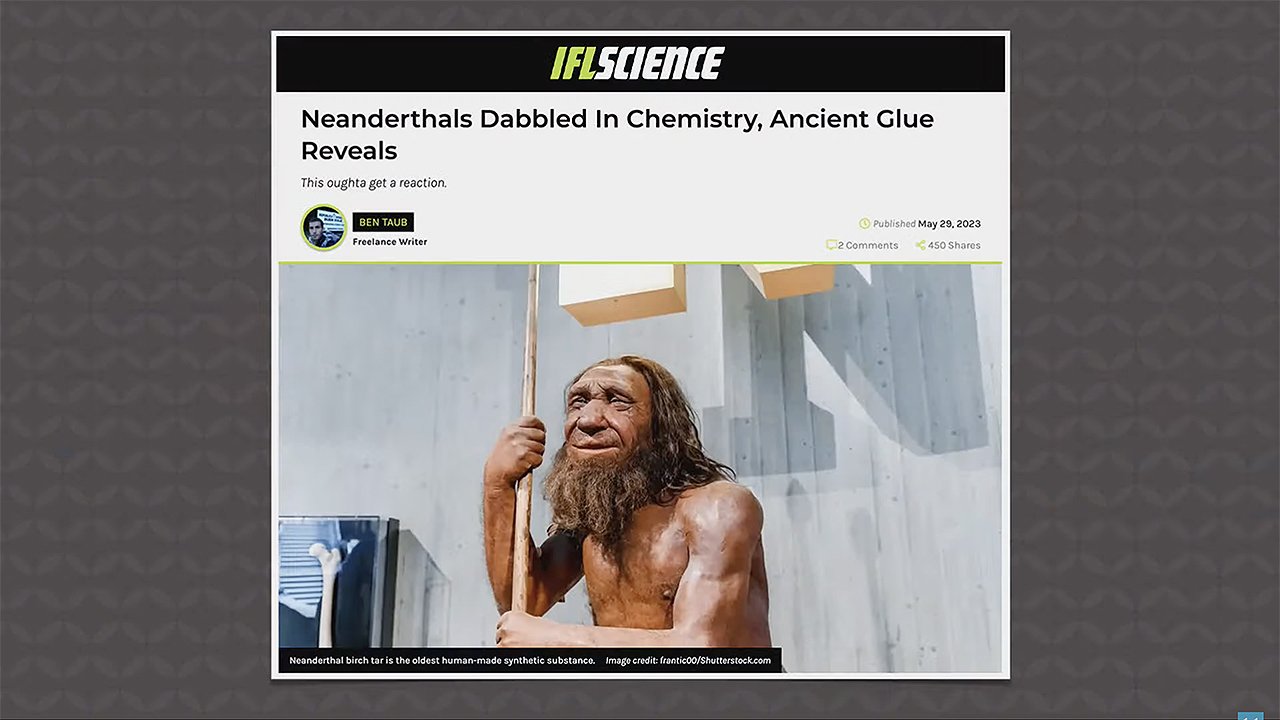
Did Neanderthals Practice Chemistry?
Before you try to insult someone by calling them a “Neanderthal,” consider that the list of Neanderthal accomplishments has grown yet again. Not only did they wear makeup and jewelry, craft tools and musical instruments, dive for fresh shellfish, and even use toothpicks and practice other dental hygiene, but a new discovery hints that they may have practiced chemistry! They sound like very intelligent humans!
Researchers discovered an adhesive, birch tar, made from birch bark at a Neanderthal site in Germany and conducted both a chemical analysis of the glue and a series of experiments to determine how these people may have made their glue. And the result was shockingly complex (for evolutionist expectations, anyway):
Analyzing samples of the ancient adhesive, researchers found that it was most likely synthesized in underground chambers that restricted oxygen flow, thus shedding light on the cognitive capacities of this prehistoric human species.
The researchers shared,
If, however, the [adhesives] were made with a method including invisible underground processes and intentionally created low-oxygen environments, such a finding would imply that Neanderthals invented or developed a technical process for transforming their material world.
This, in turn, would provide valuable insight into their cognitive and cultural capabilities.
Now, the idea of Neanderthal “chemists” shouldn’t surprise us—these people are descendants of Adam and Eve through Noah, just as we are, made in God’s image and therefore gifted with the cognitive abilities to observe the world around them, manipulate the resources God had given them, and invent new things. People in all cultures all over the world throughout history have done that—and Neanderthals were no different.
The only reason the ability of Neanderthals to synthesize complex glues is surprising is because of the evolutionary worldview which interprets Neanderthals as less-evolved cousins of ours.
The only reason the ability of Neanderthals to synthesize complex glues is surprising is because of the evolutionary worldview which interprets Neanderthals as less-evolved cousins of ours. But they weren’t our evolutionary cousins: every human being descends from Adam and Eve and then from Noah and his family. Neanderthals were humans who had some minor physical variations to us, living after the global flood during the ice age and scratching out a living during a rough time. And they were our relatives, as we are all members of the one human race—one big family.
So were Neanderthal chemists? Yes, that’s a possibility!
Get More Answers on Answers News
This item was discussed today on Answers News with cohosts Avery Foley, Tim Chaffey, and Rob Webb. Answers News is our weekly news program filmed live before a studio audience here at the Creation Museum and broadcast on our Answers in Genesis YouTube channel and posted to Answers TV. We also covered the following topics:
- If humans are unique, why are they not exceptional?
- “Am I gay?” searches soar 1,300% in 19 years.
- Are dingoes driving kangaroo evolution?
- And more!
Watch the entire episode of Answers News for June 5, 2023.
Be sure to join us each Monday at 2 p.m. (ET) on YouTube or later that day on Answers TV for Answers News. You won’t want to miss this unique news program that gives science and culture news from a distinctly biblical and Christian perspective.
Thanks for stopping by and thanks for praying,
Ken
This item was written with the assistance of AiG’s research team.
Most Recent News
-
Dec. 29, 2025 from Ken Ham Blog
Vogue magazine recently published an article asking, “Is having a boyfriend embarrassing now?”—a question the author answers with a yes!
-
Dec. 23, 2025 from Ken Ham Blog
A recent news item caught my eye when I saw the headline: “18,000 dinosaur tracks discovered along ancient Bolivian coastline.”

Answers in Genesis is an apologetics ministry, dedicated to helping Christians defend their faith and proclaim the good news of Jesus Christ.
- Customer Service 800.778.3390
- Available Monday–Friday | 9 AM–5 PM ET
- © 2026 Answers in Genesis



